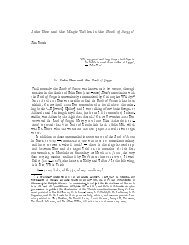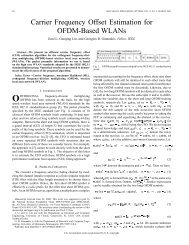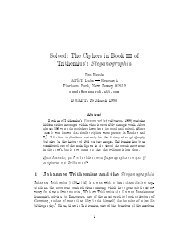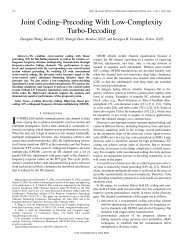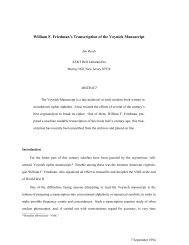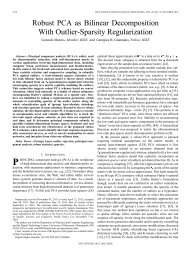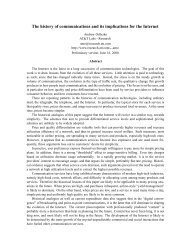PDF 209 KB
PDF 209 KB
PDF 209 KB
You also want an ePaper? Increase the reach of your titles
YUMPU automatically turns print PDFs into web optimized ePapers that Google loves.
UMSSIA<br />
INTRUSION DETECTION
INTRUSION DETECTION<br />
Sensor1 Event1, Event2… Monitor<br />
No intrusion<br />
M<br />
SensorN<br />
Event1, Event2…<br />
Alarm!
IDS CHARACTERISTICS<br />
Characteristics an IDS can be classified/evaluated by:<br />
Type of Sensors<br />
Type of Search<br />
Host IDS / Network IDS / etc…<br />
Look for known intrusions vs<br />
Look for unknown behavior<br />
Specified vs Learned<br />
Error Rates<br />
Evasion<br />
Against “typical” attacks<br />
Errors against targeted attacks
ERRORS<br />
• A False Positive error occurs when a nonintrusion<br />
causes an alarm, e.g.<br />
– Squirrel chews through sensor cable<br />
– Printer driver scans subnet for printer<br />
– User mistypes password 3x<br />
• A False Negative error occurs when an<br />
intrusion does not result in an alarm.<br />
• False Positive Rate (FPR) =<br />
#False Positives / #Normal Events<br />
• False Negative Rate (FNR) =<br />
#False Negatives / #Intrusions
BASE RATE FALLACY<br />
• Suppose the U of M has<br />
– 10M network flows each day<br />
– 100 flows are genuine intrusions<br />
• Suppose we use an IDS with a False<br />
positive rate of 0.1%. Then:<br />
– There are 10K false alarms.<br />
– So 99.9% of alarms are false positives<br />
• We would need a FPR of just 0.001%<br />
to make 50% of alarms real.
SIGNATURE MATCHING IDS<br />
• The “misuse detection” problem is to<br />
find behavior that “looks like” an<br />
intrusion.<br />
• The basic form of such systems is:<br />
1. Collect information about known attack<br />
methods and types, such as SrcAddr,<br />
SrcPort, DstAddr, DstPort, Protocol,<br />
Packet contents<br />
2. Create and look for signatures: a Code<br />
red packet, a port scan, etc…
SIGNATURE DETECTION<br />
• Language to specify intrusion patterns<br />
– 4-tuple/protocol values for potential intrusion<br />
• Eg External host -> file server (port 110, 135, …)<br />
• Eg Internal workstation -> external P2P host<br />
– Packet contents: Could be single or multiple<br />
packets (stream reconstruction)<br />
– Possibly model of protocol/app finite state<br />
machine<br />
• Lots of state in pattern matching engine<br />
• Example rule:<br />
– alert tcp any any -> myip 21 (content:"site exec";<br />
content:"%"; msg:"site exec buffer overflow<br />
attempt";)
SIGNATURE MATCHING<br />
• Advantages:<br />
– very low false positive rate<br />
– Automated extraction is possible<br />
• Disadvantages<br />
– Only detects already known attacks<br />
– Simple changes to an attack can defeat<br />
detection, for example:<br />
– scan even ports, then odd ports.<br />
– “rm –rf /*” -> “rm –rf ../../../../../../../../*”
ANOMALY DETECTION<br />
1.Try to identify what is normal, e.g. “normal”<br />
command sequence or common 4-tuple/protocol,<br />
session length, intervals, etc…<br />
2. Look for major deviations (outliers), e.g.<br />
unusual target port, source addr, or port<br />
sequence (scan)<br />
Sometimes (but not always): Apply AI/Machine<br />
Learning to “learn” what is normal.<br />
Advantage: more robust to “altered” attacks.
ANOMALOUS PROBLEMS<br />
• High false positive rate<br />
• Attacks might not be obvious until too late<br />
• Attacks can hide in “normal” traffic<br />
• Require training on “known good” data<br />
• Problems when what’s “normal” changes<br />
– Eg, flash crowds, new users, new applications…
HOST-BASED IDS<br />
… monitor a single host to detect intrusions.<br />
Typical “sensors” include:<br />
– Disk & memory contents<br />
– User input and commands<br />
– System calls<br />
… Typically equate “intrusion” with privilege<br />
escalation, eg remote ! local ! root.<br />
… Are vulnerable to various attacks, e.g.:<br />
replace HIDS process/binaries, “Mimic”<br />
attack, context problems, subvirtion.
EXAMPLE: TRIPWIRE<br />
• A “standard attack” might go like this:<br />
– Gain user access to system<br />
– Gain root access<br />
– Replace system binaries to set up backdoor<br />
– Use backdoor for future activities<br />
• Tripwire is a simple anomaly-based HIDS<br />
that monitors system binaries:<br />
– Compute hash of key system binaries<br />
– Compare current hash to earlier stored hash<br />
– Report problem if hash is different<br />
– Store reference hash codes on read-only medium<br />
• Example attack: “rootkit” replaces binaries<br />
with new versions with the same hash.
EXAMPLE: IDES<br />
IDES was a HIDS developed in the 1980s by Dorothy<br />
Denning, SRI. It worked as follows:<br />
– For each user, store daily count of certain activities<br />
• E.g., Fraction of hours spent reading email<br />
– Maintain a list of counts for several days<br />
– Report an anomaly if the current count is outside the<br />
weighted norm<br />
The main vulnerability of IDES was the ability to<br />
“train” the system to accept intrusive behaviour<br />
IDES proposed a solution: include signatures of<br />
known intrusive acts and raise an alarm if the profile<br />
matches the attack profile.
EXAMPLE: SYSCALL HIDS<br />
• In the 1990s<br />
• Build traces during normal run of program<br />
– Example program behavior (sys calls)<br />
open read write open mmap write fchmod close<br />
– Store all 4-call sequences in a file:<br />
open read write open<br />
read write open mmap<br />
write open mmap write<br />
open mmap write fchmod<br />
mmap write fchmod close<br />
• Use an “Order 4 Markov Model” to compute the<br />
probability of a new syscall sequence…<br />
– Compute # of mismatches to get mismatch rate<br />
– For example, report an anomaly if you see:<br />
open read read open mmap write fchmod close<br />
• Vulnerability: “Mimic attack”
APPLICATION-BASED IDS<br />
Example: Wagner & Dean, IEEE S&P ’01:<br />
f(int x) {<br />
open()<br />
x getuid() : geteuid();<br />
Entry(g)<br />
x++<br />
}<br />
close()<br />
g() {<br />
fd = open("foo", O_RDONLY);<br />
f(0); close(fd); f(1);<br />
exit()<br />
exit(0);<br />
Exit(g)<br />
}<br />
Entry(f)<br />
getuid() geteuid()<br />
Exit(f)<br />
Idea: Build NFA for each application, from source code.
NETWORK IDS<br />
• A network-based IDS monitors<br />
network traffic for intrusions, e.g.:<br />
– DoS<br />
– Exploiting bugs in protocol,<br />
application, OS<br />
– Install worm, virus, bot, spyware…<br />
• Challenges for NIDS:<br />
fragmentation, data volume, “low<br />
and slow” attacks…
EXAMPLE<br />
• A typical attack is “port scanning” to find<br />
out what services a host is running.<br />
• For exampe, the Nmap tool:<br />
(http://www.insecure.org/nmap/)<br />
– Determines OS/hostname/device type via<br />
“service fingerprinting” (eg, IRIX listens on TCP<br />
port 1)<br />
– Determines what service is listening on a port<br />
and can determine application name, version<br />
– Operates in optional obfuscation mode<br />
• Afterwards, attackers can exploit known<br />
vulnerabilities in the OS/applications found<br />
via Nmap.
EXAMPLE: SNORT<br />
• … is a signature-based, portable,<br />
opensource NIDS with over 2 million<br />
downloads, and 100K active users.<br />
• … scans a tcpdump log, and finds<br />
connections matching attack signatures.<br />
• … uses regular expressions that match<br />
known attacks.<br />
• Example sig:<br />
– alert tcp any any -> [a.b.0.0/16,c.d.e.0/24] 80<br />
( msg:"WEB-ATTACKS conf/httpd.conf<br />
attempt"; nocase; sid:1373;<br />
flow:to_server,established;<br />
content:"conf/httpd.conf"; [...] )
EXAMPLE: BRO<br />
• … is a high-speed “policy-based” NIDS. It uses<br />
scripts that monitor connections, and check for<br />
conformance to “expected” behavior based on<br />
protocol<br />
• … logs, for all TCP connections (via SYN/FIN/RST<br />
packets): start time, duration, service, addresses,<br />
sizes, etc. It also identifies the application based<br />
on these packets.<br />
• … supports many standard applications: DNS, FTP,<br />
HTTP, SMTP, NTP, …<br />
• … on Telnet and Rlogin generates the following<br />
events:<br />
– login_successful, login_failure, activating_encryption,<br />
login_confused, login_input_line, login_output_line<br />
• In its first five months of operation, Bro found 120<br />
UCB break-ins (60 root compromises)
DISTRIBUTED IDS<br />
• Idea: combine data from many sensors<br />
– HIDS data from many hosts<br />
– NIDS data from multiple segments<br />
• Positives: can detect “stealthy” scans,<br />
possibly lower false alarm rate, etc.<br />
• Negatives: much more data to scan,<br />
exchange, etc.
HONEYPOTS & TARPITS<br />
A honeypot is a closely monitored network<br />
decoy or decoy(s). Honeypots:<br />
– Distract adversaries from more valuable<br />
machines on a network ()<br />
– Provide early warning about new attack and<br />
exploitation trends<br />
– Frequently consist of multiple VMs that use up<br />
the “empty” IP address space on a network.<br />
A tarpit is essentially a slow honeypot<br />
that accepts connections, but prevents resets.
INTRUSION PREVENTION<br />
• Idea: respond to detected<br />
intrusion<br />
– Reset connection<br />
– Block host(s) at firewall<br />
– Etc…<br />
• Big problem: self-DoS.<br />
– Attacker makes it look like potentially<br />
legitimate connections are intrusions<br />
– Hosts get blocked at firewall
ATTACKS ON THE IDS<br />
• Witty worm: buffer overflow in<br />
commercial IDS systems<br />
• DoS<br />
– On NIDS: crash system or<br />
overwhelm monitor<br />
– Using NIDS: see IPS<br />
• Subterfuge:<br />
– Retransmits, NULs in packets,<br />
TTLs, checksums, etc..<br />
– “robot”




